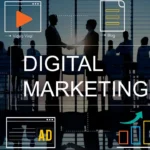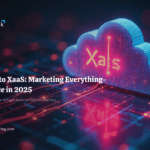Office No. 608, Lunkad Sky Station, Viman Nagar Road, Pune, Maharashtra 411014, India
Phone: +1 213-261-0597
contact@techthinkmarketing.com
Table of Contents
ToggleIntroduction
In the world of digital marketing, one phrase continues to dominate: “Content is King.” While algorithms evolve and platforms rise and fall, content remains the backbone of every successful online strategy. But what does it take to build a content marketing strategy that actually wins in 2025?
Let’s break down how content fuels digital growth and the exact steps to create a strategy that attracts, engages, and converts your target audience.
What is content marketing?
Content marketing is a strategic approach focused on creating and distributing valuable, relevant, and consistent content to attract and retain a clearly defined audience — and ultimately, to drive profitable customer action.
Rather than pushing products, content marketing builds trust, solves problems, and adds value at every stage of the customer journey.
Why Content is Still King in 2025
Why is material content marketing strategy still excellent here?
Visibility of high-quality search engines increases the SEO ranking.
Gygeneration: Material attracts possibilities and takes them down the funnel.
Marketing Authority: Valuable content creates your reliability.
Customer connection: Blogs, videos, and social posts include the audience.
Cost-effective: Compared to paid ads, materials have long-term ROIs.
AI-smart, authentic materials are more important than ever, with the discovery of the material and voting material and voice.
Key Elements of a Successful Content Strategy
To win in content marketing strategy , you just need more than ideas. A solid strategy includes:
Clear target
-
- The public persona
-
- Co-research
-
- Material calendar
-
- Material format
-
- Distribution
-
- performance measurements
Let’s do it with scratches.
Step-by-Step Guide to Building Your Strategy
Define Your Goals
Ask yourself: What do you want to achieve?
-
- Brand awareness
-
- Website traffic
-
- Lead generation
-
- Customer education
-
- Sales conversions
Your goals will guide your tone, format, and distribution.
2. Know Your Audience
Build buyer personas that detail:
-
- Demographics
-
- Pain points
-
- Online behavior
-
- Interests
-
- Buying habits
Tools like Google Analytics, Facebook Insights, and surveys help identify what your audience cares about.
3. Conduct Keyword & Topic Research
Use tools like
-
- Google Keyword Planner
-
- SEMrush or Ahrefs
-
- AnswerThePublic
-
- Google Trends
Find keywords with high relevance and low competition. These keywords should be the backbone of your blog posts, videos, and social content.
4. Plan a Content Calendar
A content calendar helps you stay consistent content marketing strategy and organized. Plan:
-
- What content to publish (blogs, videos, infographics)
-
- When to post
-
- Which channels to use
-
- Who is responsible
Example:
-
- Monday: Blog post
-
- Wednesday: LinkedIn post
-
- Friday: Newsletter or short video
5. Create High-Quality Content
Focus on value, clarity, and engagement. Use:
-
- Attention-grabbing headlines
-
- Short paragraphs and subheadings
-
- SEO-optimized text (but avoid keyword stuffing)
-
- Visuals: images, infographics, and videos
-
- CTAs (Calls to Action): What do you want readers to do next?
Remember: Write for humans first, then optimize for search engines.
6. Choose the Right Formats
Different formats suit different goals:
| Goal | Best Format |
|---|---|
| Awareness | Blog posts, videos, social media |
| Engagement | Podcasts, infographics, quizzes |
| Lead generation | Ebooks, papers, webinars |
| Sales | Case studies, product demos, testimonials |
Mix formats to cater to different stages of the buyer journey.
7. Distribute Strategically
Don’t just create—promote:
-
- Share on social media (LinkedIn, Threads, Instagram)
-
- Send newsletters
-
- Repurpose content (turn blogs into carousels or videos)
-
- Collaborate with influencers
-
- Use paid promotions (Facebook or Google Ads)
The more channels you use, the more reach you gain.
Content Types That Work Best Today
In 2025, these content formats are especially effective:
-
- Video content: Short-form (like Reels) and long-form (like YouTube)
-
- AI-powered interactive content: Chatbots, quizzes
-
- Voice-optimized content: For smart speaker users
-
- Data-driven content: Whitepapers, original research
-
- User-generated content (UGC): Builds authenticity
Also, blogs are still powerful, especially with solid SEO and keyword targeting.
Measuring the Success of Your Strategy
Track these KPIs to assess performance:
-
- Traffic: Google Analytics, Search Console
-
- Engagement: Bounce rate, time on page, comments
-
- Leads: Number of email signups, form submissions
-
- SEO rankings: Track your keyword position over time
-
- Social shares: Likes, reposts, and mentions
-
- Conversion rate: How many readers become customers
Use tools like HubSpot, SEMrush, or Hootsuite for advanced tracking.
Final Thoughts
Yes, Content is still King—but only when built on strategy, relevance, and value.
In 2025, brands that plan, produce, and promote content smartly will lead the pack. Whether you’re a solo entrepreneur or part of a growing team, investing in a well-structured content marketing strategy is your path to consistent growth, higher visibility, and stronger customer relationships.
Start small, stay consistent, and always put your audience first—that’s the real key to content marketing that wins.content marketing strategy





